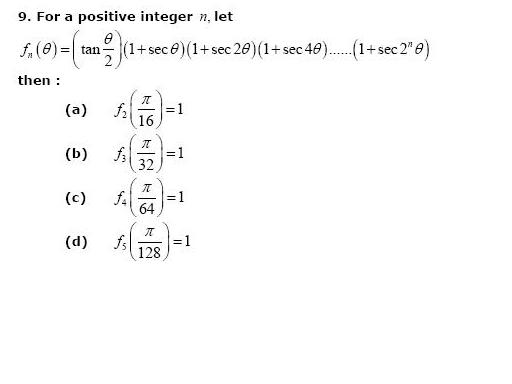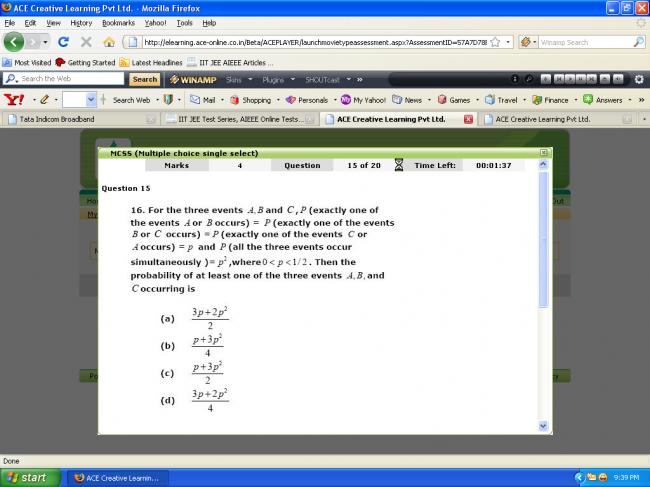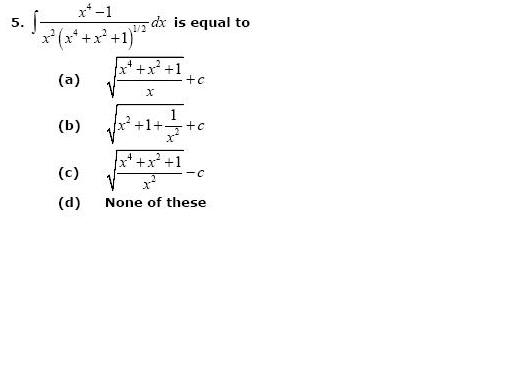ohhhhhhhhhh ok satan.........ill try thnx anyways
k next question
Q. 7
this is another multiple answer wala..........

This thread is only for math.....so NO english....dont ask doubts in eng...only math symbols are allowed....
Q.1
ohhhhhhhhhh ok satan.........ill try thnx anyways
k next question
Q. 7
this is another multiple answer wala..........

tan(A/2)=\frac{sin(A/2)}{cos(A/2)} \\ \text{Now consider} \frac{sin(A/2)}{cos(A/2)}(1+secA)(1+sec2A)....(1+sec2^{n}A) \\ = \frac{sin(A/2)}{cos(A/2)}\frac{(1+cosA)(1+cos(2A))(1+cos(4A)...(1+cos(2^{n}A)}{cosAcos2Acos4A....cos(2^{n}A)} \\ 1+cosA=2cos^{2}(A/2),1+cos2A=2cos^{2}(A/2),........[\text{We can now cancel the terms accordingly}] \\ \text{After simplification we get} \\ \frac{sin(2^{n}A)}{cos(2^{n}A)} \Longrightarrow tan(2^{n}A) \\ \text{Now its easy to substitute the options} \\ \text{Answers are a,b,c,d}
Please tell whether i'm correct or not!!!!
yo dicthum............if u use lhospital from wher will u get awkward numbers like 11e/24or e/24 eh???
Prajith..........ive specified...MULTIPLE ANSWER WALA...........and ya B is also correct....show me d working....i was confused when i tried....hehe
for ques six
just take out x2 common from the underoot below
in numerator we get
x-1/x3
now put the thing inside the denominator root =t
you get the answer
Q5
∫dx/√x(1+√x)(1-√x)
put x = cos2θ
ques is done!!!!!!!!!!!!!!!!
Q . 6
A multiple answer wala.........by looking at it we can say d answer hehe so please show d solution....

question six was already discussed in this site
put x= sinθ and proceed
q 4 is quite easy
ans will be A
as just the point will be exterior to circle and angle <pi/4
q3 iit KA HAI
ISKA ANS (A) AND (B) HOGA
BAHUT BEHAS HUI THI ISKE UPPER
for second one
apply newton leibnitz rule
we get
-cosxsin2xf(sinx)=-cosx
thus f(sinx)=1/sin2x
f(x)=1/x2
here ans=3
by symmetry we get the probability of ocurence of a,b, and c equal =x
probability that exactly one of A or B occurs =
x(1-x) +(1-x)(x)
=2x-2x2=p
probability that all occur simultaneously = x3=p2
now the probability that exactly one of these occur =
1-(probability none occurs)
=1-(1-x)3=
1-1+x3+3x(1-x)
=x3+3x(1-x)
=p2 +3/2p